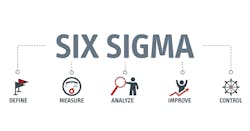It may come as a surprise to learn that most companies have some form of defect in 10% of their orders. This is a real number that represents not only an economic loss, but also potential damage to a company’s reputation. In a business world that has become more competitive than ever, supply chain quality and efficiency are crucial components in reducing order defects, minimizing costs and ensuring customer satisfaction.
A solution that has become increasingly popular for optimizing supply chain processes involves the use of Six Sigma methodology. Renowned for improving quality and efficiency, Six Sigma can transform your supply chain. This article will take you through four vital Key Performance Indicators (KPIs) and illustrate the positive impact Six Sigma can have on supply chain management and logistics operations.
What is Six Sigma?
Six Sigma is a set of methodologies and tools used to improve business practices by reducing errors, minimizing variation and increasing quality and efficiency. Six Sigma practitioners use data collection and analysis to optimize business functionality and achieve better quality control by identifying and then correcting mistakes or defects in existing processes.
Implementing Six Sigma in the supply chain involves identifying critical areas for improvement and applying DMAIC methodology (Define, Measure, Analyze, Improve, and Control) for continuous optimization.
KPI 1: Perfect Order Rate—Making Defect-Free Delivery a Reality
Imagine a scenario that involves an online retailer struggling with recurring defects in orders, such as missing or damaged items. The Perfect Order Rate, which measures the proportion of orders processed without defects and delivered on time, becomes a focal indicator for improving company operations.
To address this issue, a Six Sigma project team gathers to find a permanent solution. They first explore the root of the problem, identifying the most common types of defects and their impact on customer satisfaction. Next, they measure the current Perfect Order Rate, shedding light on the magnitude of the challenge. In the analysis stage, they deploy Six Sigma tools, including Pareto charts, to uncover the leading causes of defects.
Upon identifying the root causes, the team implements improvements, which include staff training and a review of packaging processes—ensuring greater accuracy at each step. This is where supply chain digitization comes into play. Using a warehouse management system (WMS), product locations within the warehouse can be accurately tracked, ensuring efficient inventory allocation to orders. Additionally, the WMS facilitates seamless, real-time communication between warehouse and shipping teams, reducing errors and improving order accuracy. This translates into a tangible improvement in the Perfect Order Rate, increasing customer satisfaction.
KPI 2: Cash-to-Cash Cycle Time—Streamlining Cash Flow
In this scenario, a manufacturing company faces a critical challenge: their cash-to-cash cycle, measuring the time between paying for raw materials and receiving payment for sold products, affects cash flow and the ability to invest in growth. This key metric becomes a priority for improving the company’s financial efficiency.
A Six Sigma team gathers to find solutions for this significant financial challenge. During the analysis stage, the team reveals two primary sources of the problem: delays in payments to suppliers and delays in receiving payments from customers.
Digitization once again plays a crucial role in the solution, with a transportation management system becoming an essential tool. This enables precise tracking of cash flow related to product transportation, facilitating the identification of delays in payment and revenue receipts. With this information, the company improves billing and payment processes, reducing the cash-to-cash cycle time and freeing up capital for strategic investments and sustainable growth.
KPI 3: Fill Rate—Efficiently Meeting Customer Demand
Fill Rate is the percentage of orders a company can fulfill with on-hand inventory levels. An item Fill Rate is a good indicator of order management, fulfillment efficiency and a brand’s ability to quickly meet customer demand. When a company has a higher Fill Rate, it is able to minimize lead time and prevent lost sales to items on backorder.
The company in this scenario is plagued by a low Fill Rate. To tackle this problem, a Six Sigma team identifies the root causes: delays and errors in order preparation.
The solution in this case involves the use of modern technology. This includes a voice-picking system that guides warehouse workers through product locations using voice commands, reducing human errors and significantly speeding up the selection process. As a result, a significantly higher number of products reach customers on time and without defects—increasing customer satisfaction and strengthening the company’s reputation and success in the market.
KPI 4: Inventory Turnover—Optimizing Stock Management
Inventory Turnover is the number of times a business sells and replaces its stock of goods during a given period. It considers the cost of goods sold relative to its average inventory for a year or in any set period of time. A high Inventory Turnover rate generally means that goods are sold faster, while a low turnover rate indicates weak sales and excess inventories, which may be challenging for a business.
For example, consider a food company facing the latter—low Inventory Turnover. This has led to additional costs and product spoilage due to expiration. Quick on the scene, a Six Sigma team is charged with improving this KPI. They begin by using Six Sigma measurement and analytical methodology to identify the basis of the low Inventory Turnover rate: excess stock resulting from poor demand forecasting.
To remedy the situation, the company implements a demand planning system. Using advanced algorithms and data analysis to better forecast future demand, the system helps prevent the over-purchasing of products and ensures inventory aligns more accurately with actual demand. This not only reduces costs by avoiding excess inventory, but also ensures fresh products are available when customers need them, improving customer satisfaction while building long-term loyalty.
As the demands on supply chain and logistics operations continue to evolve and intensify, the adoption of Six Sigma methodologies has the potential to become standard business practice. By helping companies streamline processes, reduce defects and minimize costs, Six Sigma can generate a positive bottom-line impact and propel businesses toward a future of competitiveness and success.
Jagan Reddy is managing partner for Netlogistik, an integrator of Blue Yonder WMS and TMS solutions.
About the Author

Jagan Reddy
Netlogistik
Jagan Reddy is managing partner for Netlogistik, an integrator of Blue Yonder WMS and TMS solutions. He is a senior executive with 20+ years of strategy, transformation and P&L management experience in enterprise software businesses ranging from $30M SaaS provider to $1B supply chain/retail software company. Reddy is a change agent instrumental in large-scale business transformations, restructurings, acquisitions and technology modernization initiatives to realize growth, profitability and sustained value.
